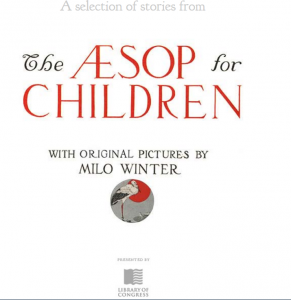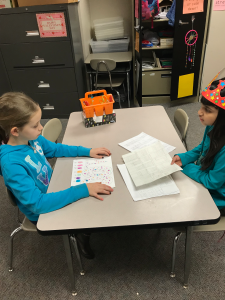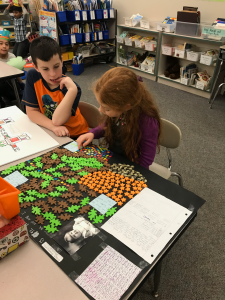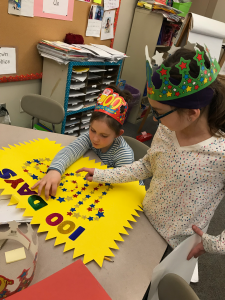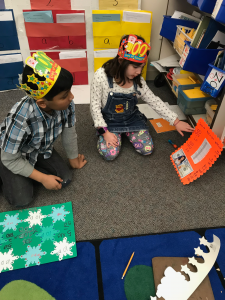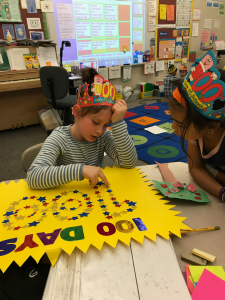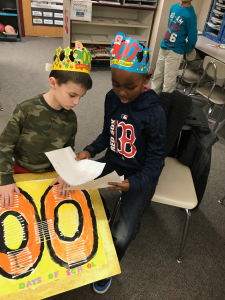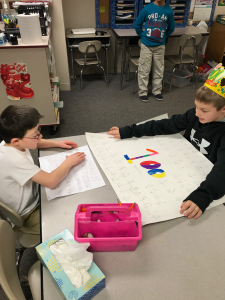Posted by kavery508 | Posted in Uncategorized | Posted on February 26, 2018
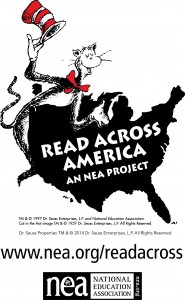 Read Across America Day is coming! This annual nationwide event is held the first week of March in honor of local author Dr. Suess’s birthday. School across the country will welcome community readers into classrooms. This Friday morning we’ll be visited by Seth’s mom, Charolette Winder, who will share the joy of reading by reading aloud to our class. Can’t wait!
Read Across America Day is coming! This annual nationwide event is held the first week of March in honor of local author Dr. Suess’s birthday. School across the country will welcome community readers into classrooms. This Friday morning we’ll be visited by Seth’s mom, Charolette Winder, who will share the joy of reading by reading aloud to our class. Can’t wait!
 Our reading focus this week is on Finding the Theme and Author’s Message. A reading theme is a big idea that we encounter again and again in literature, such as bravery or honesty or perseverance. The author’s message, on the other hand, is the moral of the story. We find evidence of it by looking at what the main character(s) learned, usually through failure. In The Gingerbread Man, for example, the theme is boastfulness. It’s a broad idea we find in many books, movies, and songs. The lesson to be learned (author’s message) is Don’t brag about yourself to others. We know this because when he did that, he came to a bad end. In any case, notice how looking at stories this way helps children to think deeply and critically about text, which is a big goal of reading instruction! You can try it at home with your young reader using any fiction story, and of course Aesop’s Fables are a great resource for finding the moral of the story. Here’s a great online collection from the Library of Congress!
Our reading focus this week is on Finding the Theme and Author’s Message. A reading theme is a big idea that we encounter again and again in literature, such as bravery or honesty or perseverance. The author’s message, on the other hand, is the moral of the story. We find evidence of it by looking at what the main character(s) learned, usually through failure. In The Gingerbread Man, for example, the theme is boastfulness. It’s a broad idea we find in many books, movies, and songs. The lesson to be learned (author’s message) is Don’t brag about yourself to others. We know this because when he did that, he came to a bad end. In any case, notice how looking at stories this way helps children to think deeply and critically about text, which is a big goal of reading instruction! You can try it at home with your young reader using any fiction story, and of course Aesop’s Fables are a great resource for finding the moral of the story. Here’s a great online collection from the Library of Congress!
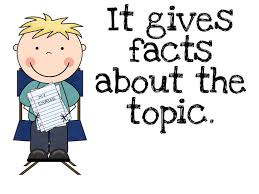 The kids have been doing a great job learning to write informative pieces that explain topics to readers. Here are some from 1) Aarika, on Dogs, 2) Cameron, on Baseball, and 3) Jaxson, on Minecraft: 1) One important thing about dogs is their sense of smell. Dogs have 25% better sense of smell than humans. 2) One important thing about baseball is knuckleball. What you do to knuckleball is you put your pinky, ring finger, middle finger, and pointer on the top of the ball and your thumb on the bottom. When you throw the ball you throw it overhand. 3) Another important thing about Minecraft is the things you can build. When you have a block, you build. If you press a button on the bottom left you place down a block and then you can build structures. Awesome!
The kids have been doing a great job learning to write informative pieces that explain topics to readers. Here are some from 1) Aarika, on Dogs, 2) Cameron, on Baseball, and 3) Jaxson, on Minecraft: 1) One important thing about dogs is their sense of smell. Dogs have 25% better sense of smell than humans. 2) One important thing about baseball is knuckleball. What you do to knuckleball is you put your pinky, ring finger, middle finger, and pointer on the top of the ball and your thumb on the bottom. When you throw the ball you throw it overhand. 3) Another important thing about Minecraft is the things you can build. When you have a block, you build. If you press a button on the bottom left you place down a block and then you can build structures. Awesome!
 Our next area of study in math involves understanding and using money. Besides identifying coins/bills and their amounts, students should be able to combine various amounts of both. Consider this example:
Our next area of study in math involves understanding and using money. Besides identifying coins/bills and their amounts, students should be able to combine various amounts of both. Consider this example:
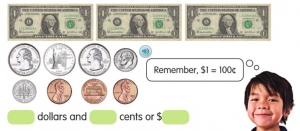 Notice how students can best solve this by starting with the larger amounts and using counting on/adding on. Students will also learn to write in dollars-and-cents notation ($1.25) and with words: one dollar twenty five cents. Students will also learn to compare 2 or more amounts of money. This can get tricky if students are still learning coin values and totaling. For example, 7 coins does not make an amount greater than 2 coins if we’re comparing 7 pennies and 2 quarters.
Notice how students can best solve this by starting with the larger amounts and using counting on/adding on. Students will also learn to write in dollars-and-cents notation ($1.25) and with words: one dollar twenty five cents. Students will also learn to compare 2 or more amounts of money. This can get tricky if students are still learning coin values and totaling. For example, 7 coins does not make an amount greater than 2 coins if we’re comparing 7 pennies and 2 quarters.
For help with homework, see the resources section of your child’s math homework folder where you will find a variety of pages on everything from coins and counting to vocabulary. If you’re following in the eBook, this is Chapter 11. Although many of us pay for things with cards instead of cash, be on the lookout for opportunities to teach your child to total amounts of coins and bills and to estimate 1) if there is enough to buy something and 2) about how much change is due!
Singing is a great way to memorize new skills! Readeez has put out a truly fantastic collection of learning songs. Here’s one of our favorites in class. You can find others (dimes, nickels, quarters, and much more) at Youtube.com and at the Readeez site.
Here’s some pics of kids doing an amazing job explaining the math in their awesome projects!

